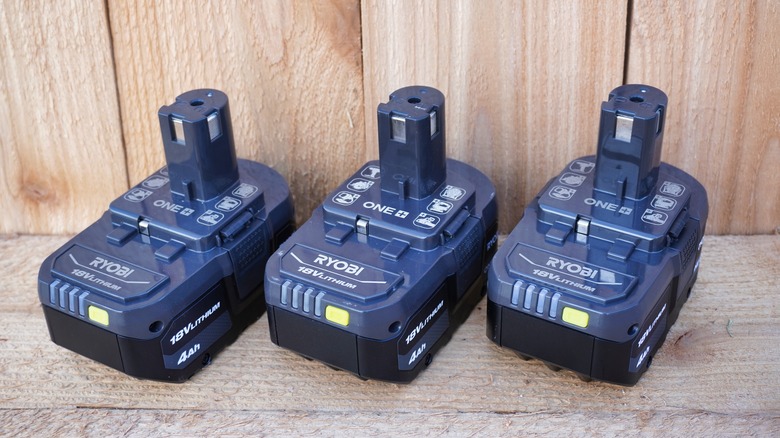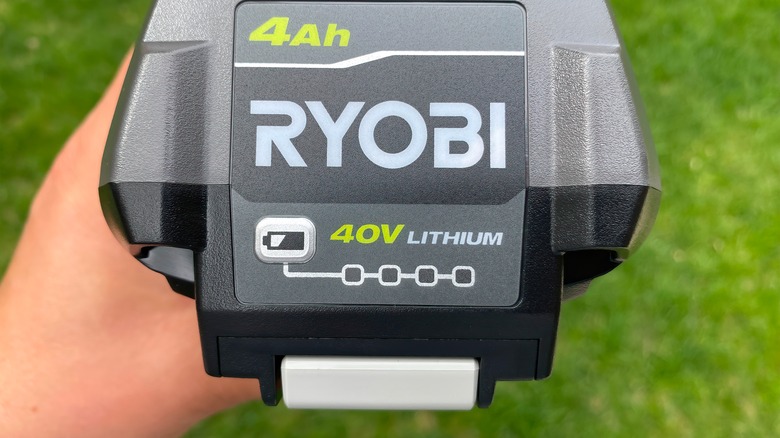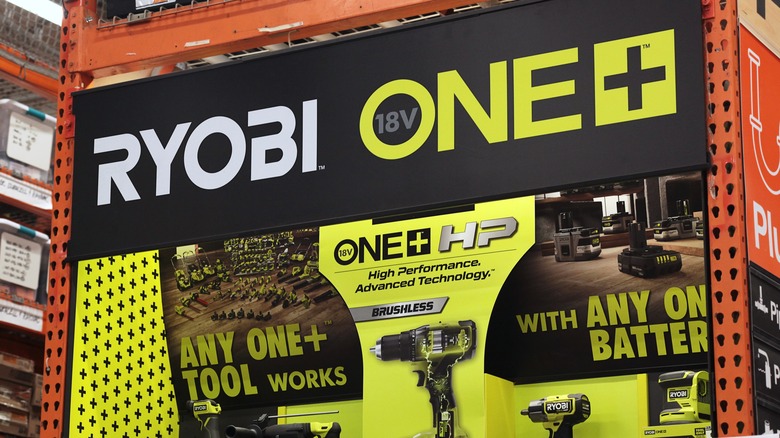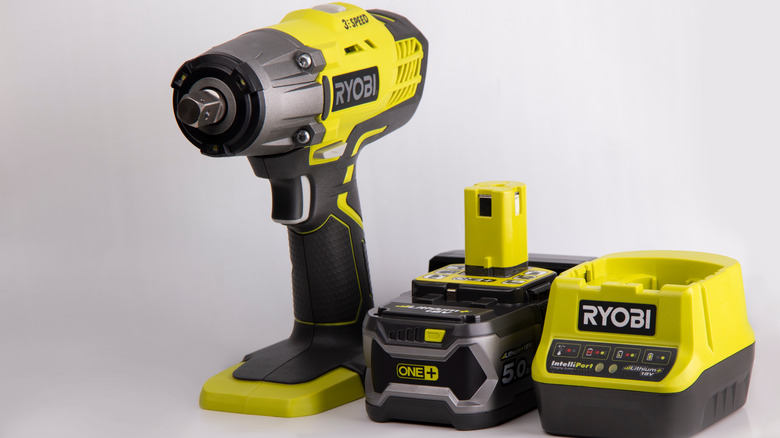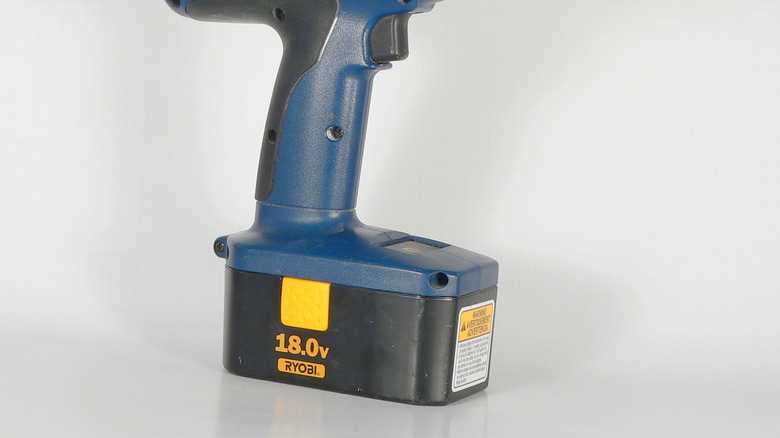How To Find The Right Battery For Your Ryobi Tool
One of the Ryobi hardware brand's best selling points is its wide array of rechargeable battery packs. Whether you're using handheld power tools or driving around on an electric ride-on lawn mower, Ryobi has a battery pack for the job, providing clean energy and consistent performance with less rumbling and fume-belching than a gas-powered tool. While Ryobi's batteries are designed to be highly adaptable, they're not quite universal in their applications.
Different Ryobi tools need different Ryobi battery packs based on their size and output. You can purchase Ryobi tools standalone from retailers like Home Depot if you already have a battery pack at home, but if it ends up being the wrong battery pack for that particular tool, you'll have to drag yourself back to the store to buy the one that you actually need. To prevent these kinds of battery mismatches from occurring, learn here about the differences between Ryobi's various battery ecosystems, how to identify them at a glance, and perhaps most importantly, which kinds of batteries can snap onto which kinds of tools.
Ryobi battery pack types
Before we get into identification, let's broadly cover Ryobi's battery pack types. Ryobi maintains four separate ecosystems for its battery-powered products, differentiated by the size and output of the batteries in question, as well as the size and application of their relevant tools.
The smallest Ryobi batteries are the USB lithium packs. These pen-sized packs are used for portable, low-power tools like small flashlights and hobby crafting tools. They can be recharged by plugging them into an ordinary USB charger or port.
The second system is the ONE+ line, Ryobi's most prominent battery ecosystem. These 18V battery packs are used to power the lion's share of handheld Ryobi tools, from power drills to vacuum cleaners and pruning chainsaws, as well as fun devices like music speakers and coolers. These batteries require a dedicated charging cradle to juice up.
For larger, professional-grade tools, Ryobi uses the 40V battery line. These heftier battery packs are designed to output a level of power comparable to a gas-powered engine. They are used on appliances like leaf blowers, power washers, and full-sized chainsaws. Like the ONE+ line, these batteries need a particular charger.
Finally, the biggest boys on the block are the 80V batteries. These packs are used exclusively for pushing and ride-on lawnmowers, providing the highest power output possible to match a gas mower. The 80V batteries need a specialized, wall-mountable charger.
Check the box and manual
When attempting to identify a match between a Ryobi tool and a battery pack, the brand provides plenty of identifying information on the product packaging. If you've just purchased a new Ryobi tool or battery pack, or are still looking at one in the store, take a good look at the box it comes in. If it's part of the ONE+ line, for example, the word "ONE+" should be featured prominently on the front of the box. The same goes for the USB lithium, 40V, and 80V lines; check the box, and you should find the answer.
If you've already disposed of the box, you can also find identifying information in the item's user manual. While the manual may not have the big, flashy logo for its relevant battery line printed on the cover, it should say which battery type it uses in plain text. If you have a Ryobi stick vacuum, for example, the cover of the manual should have "Ryobi ONE+ HP Stick Vacuum" printed in large font. Even if it doesn't say "ONE+," as long as the name of the tool has "18V" in it somewhere, you've got a ONE+ tool on your hands.
Check the tool itself
If you've lost all the packaging and the manual for your Ryobi tool or battery pack, don't worry. The tools and packs can still tell you everything you need to know. For one thing, in a nifty bit of branding, all Ryobi battery packs have their relevant system printed somewhere on their body. Whether it's a USB lithium, ONE+, 40V, or 80V, the system name should be clearly visible on a printed sticker on the battery.
If the sticker is missing or worn out, then you can determine what kind of battery you're using by inspecting the battery's connectors, as well as the connector ports on your tools. Every Ryobi battery system has a completely distinct connector shape; you can't even plug the wrong battery into a tool from a different system.
USB lithium tools have a small compartment slot that the battery pack can slide right into, usually with some kind of closable cover. ONE+ batteries are square-shaped with a distinctive peg jutting out of the top, which should plug into a cylindrical slot on the tool with the rest of the pack still sticking out. 40V batteries are bulky rectangles with connecting rails on the bottom, which slide and snap into place on an external battery slot on the tool. 80V packs look like little suitcases and need to be wholly inserted into a dedicated battery compartment on a Ryobi lawnmower. Obviously, these wouldn't even fit on any handheld Ryobi tools.
Can you use current Ryobi batteries with older tools?
It's worth noting that the current framework of Ryobi battery packs has only existed for around 20 years, while the brand itself has existed for much longer. Prior to Ryobi's current lithium-ion-powered ONE+ system, it used nickel-cadmium batteries for its 18V tools.
That said, Ryobi has used the same connector shape for all of its rechargeable 18V tools from the start. While the precise location and efficacy of the connectors do differ between generations, it is possible to power an older Ryobi tool with a new Ryobi battery, though the reliability of the output may be lessened. The other battery pack types were introduced at the same time or since the ONE+ line, so there aren't any older USB lithium, 40V, or 80V packs to worry about.
On a similar note, outside of the United States, Ryobi's battery brandings are a bit different. In Australia, for example, there's a 36V system instead of a 40V. However, the 36V Ryobi battery pack has the same connectors as a 40V pack and can be used with the same tools. Just remember to be careful if you're plugging an Australian charger into an American outlet due to voltage differences.
[Image by Greg Hume via Wikimedia Commons | Cropped and scaled | CC BY-SA 3.0]
